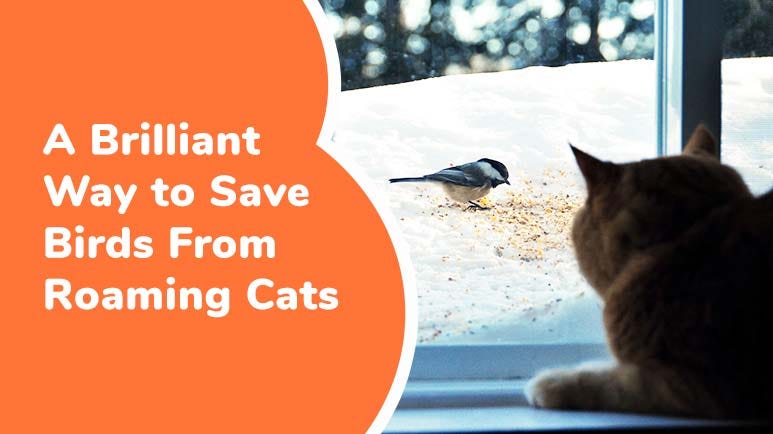A Brilliant Way to Save Birds From Roaming Cats
Cats kill between 150 million and 300 million birds a year, contributing to a serious decline in bird populations. Finally, this study has identified a creative way to help put an end to the problem.
STORY AT-A-GLANCE
A small study by the University of Northern British Columbia in Prince George suggests that when brightly colored ruff collars are placed on free-roaming cats, it reduces the number of birds they kill
Birds have excellent color vision, and the flashy collars on the cats work as an early warning system of impending stealth attacks
Like cat guardians in British Columbia, most U.K. cat owners also allow their pets outdoor access; a recent U.K. study suggests these cats are less likely to hunt and kill wildlife when fed a fresh high meat protein diet, as well as when they get 5 to 10 minutes of daily object play with their humans
Indoor-only cats are safer and healthier than free-roaming indoor/outdoor cats, but it’s also very important to find ways to give them safe access to the outdoors either through regular walks or a catio-type enclosure
Since cats are strict carnivores, a balanced diet rich in fresh animal meat, fed raw or gently cooked meets their nutritional needs and reduces the urge to kill prey animals; indoor hunting feeders and puzzles can help answer your cat’s drive to hunt, and provide both physical and mental stimulation
Scientists estimate that Canadian indoor/outdoor house cats kill between 150 million to 300 million birds a year, contributing to the overall decline in bird populations.
According to the results of a small preliminary experiment conducted at the University of Northern British Columbia in Prince George, B.C., rainbow-colored, high-visibility ruff collars appear to reduce the number of birds free-roaming house cats are able to kill while hunting outdoors.1
As luck would have it, birds have excellent color vision, and the flashy collars on the cats work as a sort of early warning system that helps the birds avoid stealth attacks.
"To the bird, this rainbow color stands out like a sore thumb," Professor Ken Otter, chairperson of UNBC's department of ecosystem science and management, told CBC News. "It's the opposite of a hunter's camo."
The experiment, which involved 14 house cats, showed that the kitties brought home fewer dead birds when wearing the rainbow collars. The project, which was started in 2019, was put on hold during the pandemic, but now Otter hopes to recruit about 40 more cats (and owners) in Prince George in the near future to provide stronger results. The cats’ owners will be required to log any birds their cat kills during one week with the collar on and another with the collar off.
The research — funded by UNBC, the SPCA, veterinarians, and the Canadian Wildlife Service — may also help Prince George determine how it regulates its free-roaming cat population.
Fresh Meat and Playtime Reduce the Feline Urge to Hunt
Similar to the feline population of Prince George, in the U.K. most pet cats also have free access to the outdoors.2 Early last year, researchers at the University of Exeter in Cornwall embarked on an innovative scientific trial to test “novel, non-invasive interventions that aim to make positive contributions to cat husbandry, alongside existing devices that impede hunting.”3
The study involved 219 cat owners in England whose pets regularly hunted outside. The researchers divided the kitties into six groups, including a control group that didn’t change their habits.
Of the remaining five groups, one was fed a high meat protein diet, the second group engaged in 5 to 10 minutes of play per day with their owners, group three was given puzzle feeders containing dry food, group four wore brightly colored collar covers so they were visible to birds, and the remaining group wore cat bells. For 12 weeks, the owners took pictures of every animal their cats brought home. The results:
Households where a high meat protein, grain-free food (freshly prepared meat, not rendered meat and not meat meal) was provided reported decreases of 36% of animals captured and brought home by cats.
Households in which owners engaged in 5 to 10 minutes of daily object play (using, for example, an interactive feather toy like Da Bird) with their cats reported a 25% decrease.
Puzzle feeders containing kibble actually increased numbers by 33%. According to the researchers:
“Increased predation in the puzzle treatment might be attributable to device novelty, insufficient training of owners and/or cats, or inability to easily access food and resulting hunger or frustration.”4
Collar covers (like those used in the Canadian study) reduced the numbers of birds captured and brought home by 42% but had no discernible effect on mammals.
Cat bells had no discernible effect.
The researchers concluded that:
“The fulfilment of cats’ physiological and behavioral requirements has not previously been considered important for managing hunting behavior, yet our study has shown that modifications to diet, and behavioral enrichment with object play, both affect cats such that they capture and bring home significantly fewer wild animals.”5
How to Give Indoor Cats Safe Outdoor Access
My opinion is that for reasons of safety and overall health and longevity, cats should be kept indoors, but with regular supervised access to the outdoors. One way to broaden your indoor kitty’s horizons and enrich her comfortable, if under-stimulating indoor existence, is to train her to walk on a harness and leash. In fact, walking your cat can be an ideal way to allow her safe, controlled access to the great outdoors.
An alternative is a catio (cat patio), which is a safe outdoor enclosure that allows your kitty secure access to the outdoors. The enclosure should be open air, allowing your cat to feel fresh air and sunlight, but shielded enough to prevent escape or a predator from getting inside.
There are also many things you can do to enrich your cat's environment, and one of them, as the study results indicate, is to set aside time for a few short play sessions each day. Discover what type of cat toys she responds to and engage her with them. Use toys that encourage stretching, reaching, jumping and running.
Feline behaviorist Dr. Marci Koski has some great advice for cat parents whose kitties have grown bored with interactive toys.
“Younger cats tend to get bored less easily,” she explains. “Cats who are young and still kittenish will play with almost anything. Older cats who’ve been around the block a few times and know how to hunt and play with their toys do tend to get bored more easily… I recommend having a number of different lures and wand toys in your toolbox.
Laser pointers are good for wearing cats out, but there’s nothing for them to bite on at the end. They’re good for exercise. Also, you can use wand toys that are like snakes, like a long ribbon of fleece. It’s good to rotate toys occasionally. And you can always marinate the lures in catnip to give them a little boost.”
This type of activity is both physically and mentally stimulating. Your cat is answering her natural drive to hunt and pounce and is getting good aerobic exercise at the same time.
This year I gave my kitties the rechargeable BENTOPAL smart interactive cat toy for Christmas and they love it. If you’re on a budget, you can’t go wrong with the original Cat Dancer; the best three dollars you’ll ever spend.
Feeding Your Cat a Meat-Based Diet
Cats in the wild thrive by consuming fresh, living whole foods. Their natural diet is moisture-dense because prey animals are about 70% water, plus it's high in protein and minerals, and moderate in fat.
Your feline family member will do best with a high moisture diet consisting of excellent-quality meat, moderate amounts of high-quality animal fat and a very low percentage of carbohydrates. This means absolutely no kibble.
My recommendation is to feed a nutritionally optimal, species-specific raw or gently cooked diet, preferably homemade, since fresh food contains the highest amounts of natural nutrients. An unbalanced diet can create tremendous health problems, so it's critically important that homemade diets meet minimum nutritional requirements. Don’t guess at what constitutes a nutritionally optimal homemade diet.
Making small, fresh batches of real food is the best way to ensure you’re delivering the maximum level of species appropriate nutrition to your cat. Here are a few homemade recipes to try (knowing you’ll have to wean your cat onto homemade food slowly, over time):
If you prepare homemade meals and cook the meat, even gently, it's a good idea to supplement taurine to ensure your kitty is getting an adequate amount. There are no known reports of taurine overdoses, so supplementation is safe. If you’ve tried getting your cat to eat less-processed, better quality food without success, watch my Facebook Live about how to wean your cat off of kibble.
I don't recommend feeding fish to cats for a number of reasons, with the exception of sardines packed in water and perhaps some wild caught salmon in rotation with other proteins.
Hunting for Food Indoors Can Ease Boredom
Since domestic cats have maintained much of their natural drive to engage in the same behaviors as their counterparts in the wild, including hunting for food, why not give them opportunities to “hunt” for their food indoors?
Try separating your cat’s daily portion of food into three to eight small meals fed throughout the day in a variety of puzzle toys or indoor hunting feeder mice. If you work outside the home, you can give him two or three food-stuffed toys before you leave the house, then a couple at dinnertime and one at bedtime.
This will encourage him to “hunt” and eat on a schedule similar to his wild cousins. As the study suggests, you’ll need to train your cat to use any food-release toys to decrease frustration and be sure he understands how to get the food out and enjoys the process.
Another way to have your cat hunt for food is by hiding his food bowls in various locations around the house. Start with one bowl in his usual spot, and then place his food portion into several additional bowls in other areas where he is sure to find them. You can also do this with puzzle toys.
If you have more than one cat in your home and they don’t (or shouldn’t) eat the same food, you’ll obviously need to keep them in separate areas of the house and insure they can’t get access to food that isn’t meant for them.
Healthypets Disclaimer: This information is for educational purposes only and is not intended to replace the advice of your own veterinarian or doctor. Dr. Karen Becker cannot answer specific questions about your pet's medical issues or make medical recommendations for your pet without first establishing a veterinarian-client-patient relationship. Your pet's medical protocol should be given by your holistic veterinarian.






When I click on the homemade recipes images in the post they all go to Dr. Mercola's Censored Library which needs a paid subscription to access the content. Is there an alternative link please? Thank you